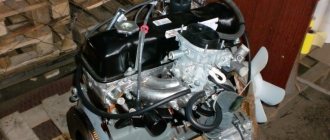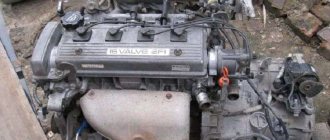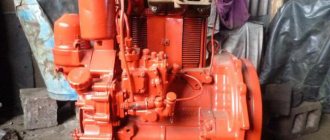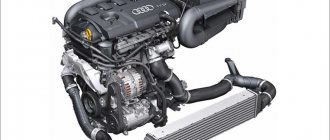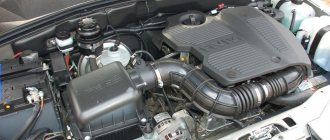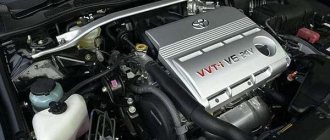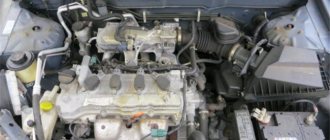Modifications
During production and operation, which lasted almost thirty years, the engine was improved and refined.
Seven main modifications of the unit were released, each of which had certain technical features. 1G-EU
Production of the model started in 79 and lasted until 88. The motor was intended exclusively for the Japanese market. The gas distribution mechanism is made with one overhead camshaft and two valves per cylinder. The first version had a compression ratio of 8.8 and a power of 125 horsepower at 5400 rpm. The '83 models had a compression ratio of 9.2 and 130 horsepower; '86 models produced 105 horsepower at 5,400 rpm.
Toyota 1G-EU engine:
1G-GEU
Production of the model started in 1983 and continued until 1988. The motor is equipped with 24 valves, the core head was developed jointly with Yamaha. The exhaust manifold was equipped with variable geometry (T-VIS). The power of the unit is 160 horsepower at 6400 rpm. Engines from 1985 had 140 horses.
Toyota 1G-GEU engine:
1G-GTEU
Production of the model started in 1986 and continued until 1988. The version was equipped with a turbine, the compression ratio of the unit was reduced to 8.5. The engine has two CT12 model compressors. The power of the unit is 185 horsepower, torque 245 Nm.
Toyota 1G-GTEU engine:
1G-GZEU(GZE)
Production of the model started in 1986 and lasted until 1992. The engine version is equipped with an SC-14 compressor, which replaced the turbine. The engine ignition is electronically controlled, the piston is designed for a compression ratio of within 8 units. The engine power is 160 horsepower, torque 210 Nm. Starting in 1989, the modification underwent modernization, as a result of which the unit marking changed to 1G-GZE. The power of the power plant increased by ten horsepower (up to 170 horses), torque increased to 230 Nm.
Toyota 1G-GZE engine:
1G-GE
Production of the model started in 1988 and lasted until 1993. In the engine, the mass air flow sensor was replaced with an absolute pressure sensor and power was reduced to 150 horsepower. The manipulations made it possible to improve the dynamics and increase the resource of the unit.
Toyota 1G-GE engine:
1G-GTE
Production of the model started in 1988 and lasted until 1991. The engine has a reinforced crankshaft, the mixture intake parameters have been changed, and a heat exchanger has been used to reduce the charge air temperature. The engine received improved 315 cc model injectors and a new electronic unit control unit. The boost pressure was 0.75 bar, the engine power was 210 horsepower, and the torque was 275 Nm.
Toyota 1G-GTE engine:
1G-FE
The production of the model started in 1988 and lasted until 2005. The engine version replaced the earlier 1G-EU unit, received a head with 24 valves instead of 12, power was 135 horses, torque 176 Nm. In 1996, the model was improved, due to which the power increased to 140 horsepower and the torque amounted to 185 Nm.
Engine 1G-FE:
Disadvantages and important features of operating the GZE installation
If the compressor on a car works perfectly and has no obvious flaws, then some other peripheral parts bring trouble to the owners.
The main problems are hidden in the prices of spare parts, some of which are simply impossible to buy analogue. Several disadvantages should be assessed before purchasing this engine for a swap or ordering a contract engine:
- There is only an original pump on the market, a new one is very expensive, repairing the pump is very difficult;
- the ignition coil is also expensive, but here there are 3 of them, they rarely break, but it does happen;
- an oxygen sensor is incredibly expensive, it is almost impossible to find an analogue;
- the design has 5 belt drives and more than a dozen rollers, which require replacement every 60,000 km;
- due to the tricky “blade” sensor, the mixture becomes too rich, a different ECU pinout or sensor replacement is needed;
- Other breakdowns also occur - oil pump, generator, throttle valve, starter (everything breaks down more due to age).
1g-gze under the hood of the Crown
It is problematic to replace the temperature sensor. Even setting the ignition on a car is not easy, since each 1G engine has its own marks and instructions. No one has original manuals anymore, and they were in Japanese. There are amateur recommendations and unofficial repair books, but you can’t always trust them. It’s good that replacing the distributor will not be necessary here, as on other units of the family; it simply isn’t there.
What cars were the 1G-GZE engine installed on?
- Crown (until 1992).
- Mark 2.
- Chaser.
- Cresta.
This engine was chosen for cars of the same type - heavy large sedans, very popular in Japan in the late 1980s. Overall the engine was a perfect fit for the car, and the Supercharger lettering on the grille is still prized on these old classic sedans by those in the know.
In Russia, these power plants are most often found on Crowns and Marks.
Tuning
JZ engine: powerful, legendary, versatile
The 1JZ engine has outstanding tuning performance. The most effective way to improve in this case is not mechanical alteration or boring of the block, modification of shafts, connecting rods and cylinders, but the installation of turbocharging.
Tuning 1JZ-GE
The first step is bootsup, a simple and effective way to add a hundred horses to the engine. To do this, the catalyst is removed, a full exhaust is made without narrowing, and 3-inch pipes are installed. Next, the standard fuel pump is changed to a “Walbro” 255 l/h, and the air intake is converted to cold to increase the pressure on the standard ECU to 0.9 bar. Then the standard computer is replaced with a boost “Blitz”, a boost controller, a Blow-Off bypass valve, and an intercooler are installed. Together, all these procedures will increase the power of the standard 1JZ engine by 100 hp.
Walbro fuel pump 255 l/h
If it is necessary to increase power to 500-600 horses, you will need to order and install a Garrett-based turbo kit, change the radiators to more efficient ones, install a high-performance injector and reinforced fuel hoses, a Walbro fuel pump already at 400 l/h and 3.5 -inch exhaust.
Walbro fuel pump 400 l/h
Using the same upgrade principle, they achieve an increase in power to 1000 hp, but such tuning is not accessible and interesting to everyone.
Engine tuning Toyota 1JZ-FSE/GE/GTE
Turbo/Twin Turbo 1JZ
Engine 1g-fe
When tuning jetzes, there is the only sure way to increase power, naturally, this is supercharging. There is no point in trying to convert 1JZ-GE into 1JZ-GTE, given the same crankshaft, the GTE block differs in oil channels and oil nozzles, in addition, building such a collective farm is a much more expensive undertaking than simply buying and installing a contract Toyota 1JZ-GTE engine, their cost is not the same too big. If you are a terribly stubborn person, then you can tinker with shafts with a phase of 264 ... 272, port the cylinder head, cold intake, throttle body from 1JZ-GTE, install forward flow on a 2.5″ pipe... in the end, you will still end up with a twin turbo swap new 1JZ-GTE. It will not be possible to completely convert the 1JZ into a 2JZ, the height of the 2JZ block differs by 14 mm and you will have to install short connecting rods, as a result we have increased loads on the connecting rods, cylinder walls, a tendency to oil burn and other joys, this is unacceptable for a powerful engine.
In general, we have a 1JZ-GTE, for urban tuning a regular boost is enough, so we install a Walbro 255 lph pump, throw out the catalyst and build an exhaust on a 3″ pipe, a full exhaust, without narrowing, a cold air intake, this will allow the standard ECU to increase the pressure from 0 .7 bar to 0.9. Next, we buy a boost brain Blitz (or another), boost controller, blowoff, intercooler and blow 1.2 bar. Such a simple chip-exhaust-pump will allow you to increase power by 100 hp, after which standard injectors and turbines run out. If the 1JZ-GTE engine still doesn’t work for you, then look further...
Next you need to order a turbo kit based on the Garrett GTX3076R turbine, a thick 3-row radiator, an oil cooler, a cold air intake, an 80 mm damper, a Walbro 400 lph pump, reinforced fuel hoses, 800 cc injectors, phase 264 shafts, a 3.5″ exhaust pipe, setup on APEXI PowerFC or AEM Engine Management Systems. Such configurations provide up to 550-600 hp, the automatic transmission on the 1JZ, with such power, will definitely require strengthening. If this is not enough, then look for kits based on the Garrett GTX3582R, the engine is forged with reinforced Carrillo connecting rods, 1000 cc boost and blow up to 700-750 hp Up to 1000 hp the 1JZ can be reached with the help of a Garrett GT4202, but only a few do this... To increase power even more, it is practiced to transfer the finished head, with everything accompanying, to the 2JZ block, thereby obtaining a larger displacement, the absence of unnecessary fuss, and significantly increased power, popularly This engine is called 1.5JZ.
ENGINE RATING: 5-
Features of "SuperNail-1GE"
Engine 1jz gte toyota
Fiber network topology
- "point-to-point";
- “point-to-point over one fiber”;
- "ring";
- “redundant ring”;
- “communication over one fiber between several communication points.”
An example of the operation of a point-to-multipoint network using SuperGvozd-1GE and broadband access equipment from other vendors. View the report To organize communication, you can use one or two single-mode or multimode optical fibers (depending on the installed SFP module). To organize communication over one optical fiber, semi-sets are used with an optical receiver and transmitter combined in one SFP transceiver. In this case, transmission and reception in one direction are carried out at different wavelengths of optical radiation, which makes it possible to ensure the maximum possible length of the regeneration section, working on one fiber. The maximum length of the regeneration section depends on the type of optical fiber and the installed SFP module and varies from 10 to 80 km. The minimum length of the regeneration section is zero. Redundancy Equipment semi-sets designed for operation at intermediate communication points provide 100% redundancy of the group stream transmitted over optical fiber, which allows for uninterrupted transmission of the group stream in the event of a fiber break in one of the sections of the fiber-optic line or in the event of a failure food at one of the communication points. Redundancy is provided by 2 SFP optical transceivers and a built-in E1 flow cross-switch. Management Network configuration, control and management of semi-sets is carried out either locally directly at the communication point or remotely using software via the Ethernet interface. Each semi-set has its own IP address specified by the user. From one communication point you can monitor and control all local and remote semi-sets in test mode. Test control mode involves a short-term change (5 minutes) of the semi-set settings. At the end of the test time, all settings set by hardware are restored.
Station Alarm The alarm output is a normally closed and normally open dry relay contact protected by a fuse.
Execution of semi-kits With power supply ~220V or -60V:
| Order code | Product name | Purpose |
| RTC.52.1 | Basic semi-set “SuperGvozd-1GE”, 4 SFP slots, 1Gb Ethernet, 24E1, 12RS-232. Power supply: 60 V. SFP modules must be ordered separately | Ring transmission with redundancy: 24E1, 2 Ethernet 1 Gbit/s each, Ethernet 100Tx - 100 Mbit/s, 12 RS-232 Power supply - 60V. SFP modules must be ordered separately. |
| RTC.52.2 | Basic semi-set “SuperNail-G”, 4 SFP slots, 1Gb Ethernet, 24E1, 12RS-232, AC 220 V Power supply - 220 V, 50 Hz. SFP modules must be ordered separately | Ring transmission with redundancy: 24E1, 2 Ethernet 1 Gbit/s, Ethernet 100Tx - 100 Mbit/s, 12 RS-232 Power supply - 60V. SFP modules must be ordered separately. |
| RTC.52.3 | Basic semi-set “SuperNail-1GE”, 4 SFP slots, 8E1, 12RS-232 Power supply: DC - 60V | Ring transmission with redundancy: 8E1, 2 Ethernet of 1 Gbit/s each, Ethernet 100Tx - 100 Mbit/s, 12 RS-232 Power supply - 60V. SFP modules must be ordered separately. |
| RTC.52.4 | Basic semi-set “SuperNail-1GE”, 4 SFP slots, 8E1, 12RS-232, Power supply: ~220V, 50 Hz OUT OF PRODUCTION. REPLACEMENT - FEED RTC.14.55 | Ring transmission with redundancy: 8E1, 2 Ethernet 1 Gbit/s each, Ethernet 100Tx - 100 Mbit/s, 12 RS-232 Power supply - 220V, 50Hz. SFP modules must be ordered separately. |
| RTC.14.55 | Semi-set board 2 SFP slots 1.25 Gbit/s, 24E1 Power: ~220V, 50 Hz Download description | Ring transmission with redundancy: 24E1+ 4 Ethernet 1Gbit/s each (Ethernet Switch 4×10/100/1000 Mbit/s) 8xE1 allocation. Case with motherboard: width 19″, height 1.5U. Power supply: ~220V, 50 Hz. SFP modules must be ordered separately. |
| RTC 52.5 | Basic semi-set “SuperNail-1GE”, 4 SFP slots, 16E1, 12RS-232 Power: DC - 60V | Ring transmission with redundancy: 16E1, 2 Ethernet 1 Gbit/s each, Ethernet 100Tx - 100 Mbit/s, 12 RS-232 Power supply - 60V. SFP modules must be ordered separately. |
| RTC 52.6 | Basic semi-set “SuperNail-1GE”, 4 SFP slots, 16E1, 12RS-232, AC 220V | Ring transmission with redundancy, SFP: 16E1, 2 Ethernet 1 Gbit/s each with SFP, Ethernet 100Tx - 100 Mbit/s, 12 RS-232 Power supply - 220V, 50Hz. SFP modules must be ordered separately. |
For multiplexer configuration, we offer you a large selection (more than 200 models) of reliable SFP modules.
Certificate of conformity: No. OS-1-SP-1539 until 07/04/2020
Malfunctions and maintenance of 1JZ-GTE
Supr owners note that due to poor fuel, the pistons can become sticky, which leads to loss of compression in the cylinders. Thanks to the very strong “bottom”, decarbonization allows you to return the compression to values of 12 atmospheres. Dead 1JZ-GTE units, despite active use by most owners, are not so common, but if necessary, you can order a contract engine. With timely oil changes, which should be done every 7,000 km, because the turbines are also washed with engine oil, the 1GZ-GTE will last 300,000 km before replacing the rings. Due to overheating, the rings may require replacement much earlier than 300 thousand. With a mileage of 300,000 km, it is also advisable to replace the crankshaft oil seal, which may begin to leak at such a mileage.
Unstable idling, as well as failures when pressing the gas pedal, can be caused by a faulty air flow sensor. It is worth noting that the 1JZ-GTE has a cast iron block rather than an aluminum one, which increases the overall weight of the car, but makes the engine less susceptible to overheating.
To increase reliability, the 1JZ-GTE engine was not equipped with hydraulic thermal gap compensators, so the thermal gaps should be adjusted at intervals of 200,000 km.
There is a Yamaha emblem on the timing housing of the Toyota Supra. The motorcycle company helped develop the engine. You can also recall the Toyota Celica 180; Yamaha took an active part in the creation of a sixteen-valve, high-speed 2.0 engine for this car as well.
The 1JZ-GTE engine was installed on:
- Chaser;
- Cresta;
- Mark II, Mark II Blit;
- Supra MK III;
- Verosa;
- Soarer;
- Crown.
The 1JZ-GTE engine is known for its wide range of possibilities for modifications and increased power. Despite the factory 280 hp, which in itself is not small, you can increase the power to 600 - 700 hp by simply replacing the attachments.
Motor characteristics table
1uz fe engine: a Toyota masterpiece
Table of technical characteristics of the 1F engine line
| Motor marking | Production period | Power indicators / crankshaft rotation frequency | Torque indicator / crankshaft speed | Compression level | Number of cylinders per valve |
| 1G-EU | 1979-88 | 125/5400 | 160/4400 | 8.8 | 2 |
| 1G-GEU | 1983-88 | 160/6400 | 186/5200 | 9.2 | 4 |
| 1G-GZE | 1986-92 | 170/6000 | 230/3600 | 8.0 | 4 |
| 1G-GTEU | 1986-88 | 185/6200 | 245/3200 | 8.5 | 4 |
| 1G-GE | 1988-92 | 150/6200 | 186/5400 | 9.5 | 4 |
| 1G-GTE | 1988-91 | 210/6200 | 280/3800 | 8.5 | 4 |
| 1G-FE | 1988-96 | 135/5600 | 180/4400 | 9.6 | 4 |
| — | 1996-98 | 140/5750 | 185/4400 | 9.6 | 4 |
| 1G-FE VVTi | 1998-2001 | 160/6200 | 200/4400 | 10.0 | 4 |
History of the Toyota 1G-GPE engine
In 1988, the 1G-GEU was replaced by the 1G-GE model and, at the same time, gas fuel equipment for running on propane was installed on this model and assigned the index 1G-GPE. To facilitate cold starts in winter, a heater was installed on the gearbox. This model was based on the 1G-FE series; with the help of Yamaha, the cylinder head was changed, which made it possible to increase the power of the internal combustion engine. This model was made for the Japanese domestic market and for the Crown comfort model.
Technical characteristics of the Toyota 1G-GPE engine
| Type of cylinder arrangement | in-line |
| Number of cylinders | six |
| Number of valves per cylinder | four |
| Piston stroke, mm | 75 |
| Piston diameter, mm | 75 |
| Compression ratio | 8.5 |
| Engine capacity, cm 3 | 1 988 |
| Engine power, l. s./about. min. | 110/5 600 |
| Torque, Nm/rev. min | 152/2 400 |
| Fuel, GAS | Propane |
| Engine weight, kg | – |
| Fuel consumption, l/100 km | |
| City | – |
| Route | – |
| Mixed cycle | – |
| Engine life, t. km | 350 + |
| ICE potential in l. With. | – |
Repair and operation
The engines are designed to operate with fuel - AI-92 - AI-98. On 98-eighth gasoline it happens that it doesn’t start well, but it improves performance. 2 knock sensors are installed. There is no starting injector; the internal combustion engine crankshaft position sensor is located in the distributor.
Platinum spark plugs need to be replaced every 100,000 km, but to replace them you have to remove the top of the intake manifold.
The normal volume of engine oil is 5 liters. The volume of coolant is 8 liters. A standard fan is installed on the shaft of the internal combustion engine.
A vacuum air flow meter was installed. To replace the oxygen sensor, you will have to go through the engine compartment from the exhaust manifold.
Depending on the manner of operation, major engine repairs have to be done by some after 300,000 km, and by others after 350,000 km.
The main part in such engines that often breaks is the timing belt tensioner pulley. The oil pump (oil pump), which is similar to the VAZ one, also sometimes fails. Average fuel consumption is 11 liters per 100 km.
Conclusions on the old Japanese “six” 1G-GZE
Several conclusions can be drawn about this engine. The unit is great for a swap if you want to replace a failed engine on a Mark 2 or Crown. It is better to buy the device from Japan, but remember some of its subtleties. Diagnostics are complex, so if the speed of your purchase is jumping, there may be a dozen reasons for this problem. When installing, you should find a good technician.
Reviews claim that 1G lasts for a long time after being idle. This is a disease of the entire series, since the injector and ignition system is no longer new. The manufacturability of the engine is assessed by the parameters of the late 80s of the last century; today the engine is already quite outdated. But in general, the unit can please the owner with an economical highway trip and fairly good throttle response in any conditions.
Design Features
The 1GR inline 6-cylinder engine is built on a cylinder block made of gray cast iron. The use of such material made it possible to do without liners; the working surface of the cylinders is the processed metal of the block. Early versions have a 12-valve aluminum cylinder head with 1 camshaft. Later, internal combustion engines began to use a part with 24 valves and 2 shafts to drive the intake and exhaust valves, respectively.
On an early engine with 1 or 2 camshafts, the mechanism is driven by a belt. In 1988, a block head that was reduced in width was developed. The reduction in size was achieved by changing the drive circuit - only 1 shaft rotated from the belt. To drive the other, helical gears were used. Timing marks applied on the camshaft gears allow you to correctly set the valve timing. On all engine modifications except Beams, a broken belt does not damage the valves and pistons.
To supply fuel, distributed injection with an electronic controller (EFI system) is used. The cooling system fan is equipped with a special clutch that turns on when the temperature threshold is exceeded. The ignition system of early modifications includes 3 ignition coils connected to cylinders numbered 1-6, 2-5 and 3-4. Beams engines began to use individual coils located in spark plug wells.
The installed turbochargers are equipped with boost pressure regulators. Early engines used open-loop catalytic converters. Later, improved components began to be installed that ensure automatic adjustment of the mixture composition.
Engine problems and shortcomings
Serious breakdowns do not occur in 1G FE. Low engine speed and the absence of electronic devices in the stock version make the internal combustion engine repairable and reliable. However, do not forget to change the engine oil and filter every 7,500 - 10,000 km or once a year
This is especially important for BEAMS. Dirty or low-quality oil clogs the solenoid valves, which leads to system malfunctions
And changing valves is expensive.
In the 1G-FE BEAMS internal combustion engine, when the timing belt breaks, the valve stems bend. To avoid major repairs, it is necessary to monitor the condition of the drive and change the belt along with the oil pump every 100,000 km. Spark plugs and fuel filter last no more than 20,000 km. During maintenance, it is also necessary to adjust the thermal clearance of the valves: for inlet valves 0.15 - 0.25 mm, for exhaust valves - 0.25 - 0.35 mm.
If you accelerate too much in winter without warming up the engine, you can get many problems, from oil leakage to cutting off the timing belt teeth. Lubricant leakage occurs through a faulty pressure sensor, stiffened rings and outdated valve stem seals. In the first releases of the 1G FE engine, the pressure sensor was the “weak link” - it malfunctioned and quickly broke down.
A flickering tachometer needle at idle, as with many engines, indicates a faulty throttle body or IAC sensor, a clogged throttle body, or fogging around the valve cover gasket.
On older units, oil consumption occurs: more than 1 liter per 1000 km. The problem arises when the oil receiver in the pan becomes clogged and the oil scraper piston rings become coked. To eliminate the malfunction, the engine must be completely cleaned, gaskets, bearings, worn oil seals and valve stem seals replaced, i.e. make minimal repairs.
With age, the ignition also malfunctions: in the 1G FE, the wires wear out and the distributor breaks. In the BEAMS model, the ignition coils need to be replaced.
1G-FE BEAMS
A major stage of modernization of this engine took place in 1998. In connection with the release of the Altezza model, Toyota's designs were faced with the task of providing an increase in power and dynamic characteristics without changing the engine configuration.
As a result, the frequency at which the engine crankshaft rotates has been increased, along with the compression ratio. Also, modern electronic devices are used in the cylinder head. This updated type of engine can be distinguished by the Beams prefix at the end of the marking. Translated from English, this means the last stage of modernity of the engine, which it occupied in 1998.
The names of the 1G-FE and 1G-FE Beams power plants are similar, however, they are structurally significantly different. Therefore, the interchangeability of parts of these engines is impossible.
Updated 1JZ-GTE, 1996
In 1996, the Japanese updated the engine, and so the 1JZ-GTE vvti appeared. In addition to the fact that the turbo engine received a system that changes valve timing, twin turbo is a thing of the past. The Japanese, instead of two parallel turbines, began to install one, but larger turbine - CT15B.
1JZ-GTE VVT-i
In addition to changes affecting the supercharging system, the updated engine received a higher compression ratio. If on engines with two turbines it was 8.5:1, then the single-turbine 1JZ-GTE has a compression ratio increased to 9.0:1. The increased compression ratio made it possible to increase torque to 379 N.M and make the power plant 10% more economical. Quite high compression, as for a turbocharged engine, places high demands on the quality of gasoline. It is recommended to power the 1JZ-GTE engine with gasoline with an octane rating of at least 95, and given the unsatisfactory quality of our fuel, to avoid the risk of detonation, it is better to fill with 98-octane gasoline.
In the 1996 1JZ-GTE, the cooling channels were changed, which reduced the likelihood of engine overheating. The geometry of the engine did not change during the modernization: both before and after restyling, the cylinder diameter is 86 mm and the piston stroke is 71.5 mm. Such engine geometry, when the cylinder diameter exceeds the piston stroke, determines the superiority of torque over maximum power.
Despite the fact that the characteristics of the modernized 1JZ-GTE “on paper” have improved, the twin-turbo engine at the “top” spins “more fun”, precisely for this reason, some of the tuning fans are looking for the pre-restyling 1JZ-GTE twin turbo.
The average fuel consumption of the 1JZ-GTE is stated at 12 liters, but in real conditions the consumption easily increases to 25 liters.
| 1JZ-GTE Twin Turbo | 1JZ-GTE VVT-i | |
| Year of release | 1990-1995 | 1996-2007 |
| Volume | 2.5 l. | |
| Power | 280 hp | |
| Torque | 363 N*m at 4800 rpm | 379 N* m at 2400 rpm |
| Compression ratio | 8,5:1 | 9:1 |
| Cylinder diameter | 86 mm | |
| Piston stroke | 71.5 mm | |
| Turbine | 2 turbines CT12A (pressure 0.7 bar) | 1 turbine CT15B |
Review of faults 1JZ GE
The motor is considered reliable, but malfunctions, one way or another, arise over time. Let's look at the most well-known, common problems:
Startup problems. The cause is usually related to the spark plugs. They need to be checked and, if necessary, cleaned or replaced.
It is important to remember that the Toyota engine is afraid of cold and frequent washing; Troubleshooting, unstable operation at various speeds. Troubling is also due to flooded spark plugs
This also happens due to the fault of the driver who forgets to warm up the engine well in winter. As for unstable speeds, the reason must be sought in the VVTi valve, XX sensor, throttle valve. The engine will work again like new after washing the listed parts; Increased oil and fuel consumption. As a rule, the first malfunction occurs due to a faulty oxygen sensor or clogged filters. The oil burn appears over time. On an old engine, it’s time to change the valve stem seals, rings, or decarbonize; Increased noise. It is more like a crackling noise and is caused by a low clutch life. Unadjusted valves and connecting rod bearings can also knock. In some cases, this may be due to the idler roller bearing.
The viscous coupling of the 1JZ GE engine often deteriorates. Its malfunction can be determined by traces of antifreeze under the car.
1G service regulations
The power units of the 1G series were unpretentious, did not require expensive oils and high quality fuel, systematic maintenance of these engines made them indestructible. All the owner had to do was perform the simplest steps described in the manual. The correct selection of oil and its timely replacement are important; the filter element must also be replaced at each oil change.
Thus, the maintenance of this engine should be like this:
- Change the oil every 7,000-10,000 kilometers, as well as install a new filter;
- The drive belts of attachments are checked every 30 thousand km; they should be replaced after 10,000 km. mileage;
- Every 10,000 km. the condition of the cooling system should be checked, the pump life is about 50 thousand km, and the antifreeze should be changed every 3 years;
- It is recommended to change the air and fuel filters after every 20,000 kilometers, otherwise on engines equipped with superchargers there may be irreversible consequences due to driving on a lean mixture;
- Every 30 thousand kilometers it is recommended to adjust the valves; they are adjusted by replacing the washers in the pushers; hydraulic compensators are not provided in these power plants; in the 1G-FE BEAMS engine, valve adjustment is carried out by replacing the pushers;
- Spark plugs require replacement after 30-50 thousand kilometers, depending on the modification; it is worth understanding that untimely replacement can kill the ignition coils on 1G-GZE and 1G-FE BEAMS engines;
- The timing belt should be changed every 100,000 km. mileage, on the 1G-FE BEAMS engine, its condition should be monitored more often, since this power plant bends the valves when the belt breaks, but in general, 1G series engines do not bend valves when the timing belt breaks or jumps.
Replacing timing belt 1G-FE BEAMS
Review of faults and repair methods
Power plants of the 1G series do not cause any special problems to the owner; basically, all malfunctions appear due to untimely maintenance and wear.
- Oil burns can be observed after 200,000 km. mileage, the culprit is very often the oil seals, in 90% of cases they just need to be replaced and the oil burn will disappear, but if this does not help, then the oil scraper rings are stuck, decarbonization helps some instances, but most often an engine overhaul is required
- Poor engine starting in the cold season is caused by pinched valves, it can be treated by regular valve adjustment, very often in cold weather the engine does not start due to a non-working cold start injector, it was installed on early versions of the 1G engine, in this case the cold start injector thermostat will need to be replaced, many car enthusiasts force the injector to turn on;
- A low oil pressure alarm is almost always associated with a malfunction of the oil pressure sensor, but if replacing the sensor does not help, then the oil pump and bearings should be inspected;
- Unstability of idle speed is due to problems with the idle speed sensor, cleaning or replacing the sensor helps, also on the 1G-FE BEAMS engine this may also be due to the VVT-i system, if it fails, then floating speed and decreased engine power will cause you provided for;
- Also, the throttle position sensor often fails, then you get a cutoff at certain speeds, increased fuel consumption and starting problems;
- The oil pump seal often leaks, this entails the rapid death of the timing belt, this is not so bad on almost all 1G series engines, but the 1G-FE BEAMS engine bends the valve and if the timing belt breaks on it, the consequences will be irreversible, so it’s worth keeping an eye on for engine dryness in the timing belt area
- On engines equipped with superchargers, one of the diseases is a breakdown of the cylinder head gasket, there is only one way out, replacing the gasket with the original, analogues do not last long.
1G
Since the engine was produced in only one size, all G series engines are designated 1G
, and the same cylinder diameter and piston stroke of 75 millimeters.
1G was installed on cars:
- Toyota Soarer
- Toyota Celica Supra
- Toyota Crown
- Toyota Cressida
- Toyota Altezza
- Lexus IS200
Engine 1G-EU under the hood of Toyota Crown, 1982
1G-FE engine under the hood of Lexus IS200
Engine 1G-GE, 1982
Engine 1G-GTE, 1985
1G-EU
Japanese version, 1G-EU
, produced from 1979 to 1988. This engine had two valves per cylinder and one camshaft. Its power was 105-125 hp. With. (78-93 kW) at 5400 rpm, torque 157-172 Nm at 4400 rpm.
1G-FE
Engine 1G-FE
DOHC uses low valve lift and other fuel economy optimizations. This engine appeared in 1988. Its power was 135 hp. With. (101 kW) at 5600 rpm, torque 176 Nm at 4400 rpm. In 1998, a version with VVT-i appeared, producing 160 hp. With. (119 kW) at 6200 rpm and torque of 200 Nm at 4400 rpm on the Altezza/IS 200. With the end of the first generation Lexus IS, production of this engine was discontinued in 2005.
1G-FE was installed on cars:
- Toyota Altezza/Lexus IS 200
- Toyota Crown
- Toyota Chaser
- Toyota Mark II
- Toyota Cresta
- Toyota Chaser
1G-GEU
The 1G-GEU 24-valve DOHC engine was designed for high performance and featured a dual-chamber combustion chamber. The engines were produced from August 1982 to 1986, mainly for the Japanese market. Engine power was 140-160 hp. With. (104-119 kW) at 6200 rpm and torque 162-181 Nm at 5600 rpm. It was Toyota's first twin-cam engine with four valves per cylinder, and received the JSME Medal for New Technology award in 1982. To minimize the shortcomings of its design, the 1G-GEU was equipped with T-VIS, a variable intake manifold geometry system that made it possible to increase torque by changing the geometry of the intake manifold depending on engine speed. Like all subsequent Toyota cars with two camshafts, the timing drive was belt driven, unlike the chain drive, which had lower noise levels and lower maintenance requirements. In August 1983, the fuel injection system was changed to EFI-D, which measured intake manifold pressure to determine the correct air/fuel mixture.
1G-GEU was installed on cars:
- August 1981—1985 GA61
- August 1982-? Toyota Chaser/Mark II/Cresta
- August 1983-? Toyota Crown
- February 1983-? Toyota Soarer
1G-GE
Engine 1G-GE
succeeded by
1G-GEU
in 1988. Engine power dropped from 160 to 150 horsepower, the engine was installed on the same cars as 1G-GEU. It was produced until 1993.
There were at least 3 variations of this engine: pre-restyling (with blue inscriptions on the valve covers), restyling (with red inscriptions) and modified restyling. All changes were minor and concerned the shape of the valve covers, the geometry of the intake manifold and related components.
1G-GTE
24-valve DOHC engine 1G-GTE
became the first turbocharged engine in the series with two superchargers CT-12. There were three generations of this engine with air-to-air and air-to-water intercoolers, producing power from 185 to 210 hp. With. (138-157 kW) at 6200 rpm and torque from 234 to 275 Nm at 3800 rpm, respectively. It was the most powerful engine in the G series. In May 1991, it was replaced by a 180 hp engine in most of the cars.
1G-GTE was installed on cars:
- 1986–1992 ( GA70
chassis , Japan only) - 1988—1992 // (GX81 chassis
) - 1986—1991 (GZ20 chassis
)
1G-GPE
1G-GPE
was a 1G-GE engine running on liquefied gas. Its power was 110 hp. With. (81 kW) at 5600 rpm and torque of 152 Nm at 2400 rpm.
1G-GPE was installed on cars:
Toyota Crown Comfort
1G-GZE
1G-GZE
was a supercharged version of the engine and was produced from 1986 to 1992. Its power was 168 hp. With. (125 kW) at 6000 rpm and torque of 226 Nm at 3600 rpm. Like the turbocharged version, it was a 24-valve DOHC engine, but differed in the ignition system (DIS). 1G-GZE was installed only in conjunction with an automatic transmission. It was replaced by the Mark II/Chaser/Cresta in August 1991, remaining on the Crown until 1992.
1G-GZE was installed on cars:
- Toyota Crown GS120, GS121, GS130, GS131
- 1988—1990 Toyota Mark II/Chaser/Cresta GX81
Description of 1G series motors
At the end of 1970, Toyota felt the need to replace the old series of 7M engines with a more advanced one, and in 1979 the first engine of the 1G line was developed, coded 1G-EU, which has a square architecture - the piston stroke and cylinder diameter are 75 mm, the volume of the power plant equal to two liters, was equipped with an EFI injector, had 12 valves and one camshaft. Mark-shaped ones in 50s bodies were the first to receive this power plant.
1GEU first engine of the 1G series
Later in 1982, Toyota introduced Yamaha to the engine and the 1G-GEU unit was released. This unit received a two-shaft cylinder head, 4 valves per cylinder and had impressive power from such a volume - 160 horsepower from just 2 liters. The engine turned out to be high-speed and had a wonderful sound; the reliability of the power plant was also enviable.
In 1985, two new engines with superchargers were released, 1G-GZE with 165 hp. and the 1G-GTE, which developed 185 horsepower, both powerplants were breakthroughs for their time.
1G-GZE was equipped with a compressor and developed 165 hp.
1G-GZE is a compressor modification of 1G; in this unit, Toyota for the first time moved away from distributor ignition, using a separate coil for each cylinder. The engine was equipped with an SC14 compressor, which is still used to this day for tuning cars of different classes. The compression ratio of this power plant is 8.0.
1G-GTE 2 liter turbo unit
1G-GTE - a turbocharged version, equipped with two small CT12 superchargers and operating at a pressure of 0.4-0.5 bar, equipped with a liquid intercooler, which made it possible to develop 185 horsepower with a compression ratio of 8.5. After modernization, the power unit received new injectors, an air intercooler and developed a power of 210 horsepower.
The photo shows a classic representative of the 1G series, a distributor, two-liter engine developing 135 horsepower.
In 1988, the outdated 1G-EU was replaced by a basic modification of the 1G-FE engine, the power plant featured 24 valves per cylinder, had electronic fuel injection with a MAP sensor, developed a power of 135 horsepower and had a compression ratio of 9.6. Soon this engine became one of the most popular and was installed on cars until 1998.
1G-FE BEAMS, the latest version of the 1G series engines
All power plants were equipped with a cast-iron cylinder block, a timing belt drive and an EFI injection system, the service life of the power plants exceeded 500 thousand km, and the 1G-FE engine can be considered a million-dollar engine, this power unit is very reliable, it could travel 15,000 km. without changing the oil and not losing service life.
Motor modifications
The 1G engine has several modifications, which are presented below:
- 1G-EU - The first version of this engine was installed in 1979 on a Toyota Crown. The compression ratio in it is 8.8, the power indicator, at a crankshaft speed of 5400 rpm, reaches 125 hp. The torque indicator is 160 Nm, at a rotation speed of 4400 rpm. In 1983, adjustments were made, due to which there is a decrease in power by 20 units and torque by 14 units, at the same crankshaft speeds. This unit was installed on the following models: Toyota Chaser X60, Cresta X50/X60/X70, Crown S110, Mark 2 X60, Soarer Z10/Z.
- 1G-GEU. Its release lasted 5 years, from 1983 to 1988. This is an engine whose manifold is equipped with controls to change the geometry of the exhaust gas flow, and 24 valves are installed in its cylinder head. This contributed to an increase in power to 160 hp. and torque up to 186 Nm. In 1985, designers reduced the number of horsepower of the car to 140 units. Installation was carried out on these vehicles: Toyota Chaser X70, Mark 2 X60/X70, Cresta X60/X70, Crown S120, Soarer Z10/Z20, Toyota Supra A.
- 1G version GTEU - the production history of this type lasted three years, from 1996 to 1988. This engine is distinguished by the fact that a turbo element was installed in it. This reduced the compression ratio to 8.5. The design of the power plant includes two turbochargers labeled CT When creating a pressure of 0.5 bar, the power parameters produced by the engine are equal to 185 hp. at a crankshaft speed of 6200 rpm. And the torque value reaches Nm at an engine speed equal to rpm. Vehicles with a 1G-GTEU engine installed under the hood: Toyota Chaser X70, Mark 2 X70, Cresta X70, Soarer Z20, Toyota Supra A70.
- 1G-GZEU/GZE was produced from 1986 to 1992. Unlike the previous engine, the turbine was replaced with an SC-14 compressor unit. Its compression ratio was 8, so the piston was replaced. Also, for the first time, an electronic ignition system was used in this power unit. At 6000 rpm, the engine produces 160 hp. Torque parameters are equal to 210 Nm when the tachometer value is kept at around 4000 rpm. As a result of the modernization of the product, which was produced in 1989, they began to be labeled GZE. The pressure pumped by the compressors was 0.5 bar. When the engine speed reaches 6000 rpm and 3600 rpm, the power and torque values are 170 hp. 230 Nm respectively. Compressor engines were installed on the following Toyota car models: Chaser X80, Mark 2 X80, Cresta X80, Crown S130 and Soarer Z20.
- 1G-GE. The beginning of its production dates back to 1988, and its completion in 1993. A sensor was installed in it, which determined the absolute pressure, which replaced the Mass Air Flow Sensor. There is a decrease in maximum power, relative to the GZE engine, by 20 hp. and maximum torque of 44 Nm. These parameters are achieved when the crankshaft rotates at speeds of 6200 and 5400 rpm. Cars produced with the 1G-GE engine: Toyota Chaser X80, Mark 2 X80, Cresta X80, Crown S130, Soarer Z20, Supra A70.
- 1G-GTE is a modified version of the 1G-GTEU engine. The manufacturer modernizes the crankshaft, intercooler, injectors, and intake system. Thanks to this, the pressure increased to 0.75 bar. Power figures and torque were 210 hp. and 275 Nm at crankshaft speeds of 6200 and 3800 rpm. Installation was carried out on cars where 1G-GE was installed, with the exception of Toyota Crown.
- And finally, the final, most successful and long-produced engine, marked 1G-FE. This motor was first produced in 1988 and continued to be produced for 17 years. In terms of design features, it resembles the 1G-GEU with a narrowed cylinder head with 24 valves. This unit replaced the 1G-EU. 135 hp power and 176 Nm of torque, this engine produced.
Tuning and boosting - what is available for GZE?
Enthusiasts are engaged in increasing engine power. At Stage 3, when almost all parts are changed, including the crankshaft, exhaust manifold, intake system, exhaust and even electrical circuits, the engine potential exceeds 320 hp. And at the same time, the resource remains more than 300,000 km.
Platinum spark plugs were installed on the engine from the factory. Finding the same ones is very difficult, their cost is high. But when installing any other ignition elements, the engine loses power. So for maximum potential you will need a fair amount of money. And the motors are no longer the newest to experiment with their power and lifespan.
The main problems and troubles with the 1G-GE motor
Despite the simple classical structure and design, operation problems are popular. Today, the main disadvantage of power plants of this type is age. With high mileage, the most unpleasant problems appear, which are extremely expensive and difficult to repair.
But there are also a number of childhood diseases of the early inline six from Toyota:
- The Yamaha cylinder head caused problems, but the GEU motor, the predecessor of the 1G-GE, is known for a lot of problems.
- Starter. With age, this unit began to cause serious distress to car owners, and from the very beginning there were many complaints about it from motorists.
- Fuel injection system. The throttle valve itself works well, but the injector has to be serviced regularly; its system is far from ideal.
- Major renovation. You will have to search for a long time for connecting rods, repair pistons, and also carefully bore the cylinder block to avoid its destruction.
- Binge on butter. For 1000 km, after 200,000 km, this unit can consume up to 1 liter of oil, and this is considered the factory norm.
The process of servicing and repairing this unit is quite complex. Just what does it cost to replace the collector or restore it? You will have to spend a lot of time at the service just to remove the devices for inspection. In the 1G series, Toyota tried to show all its engineering wonders. But GE in this case is not the worst option. For example, version 1G-FE BEAMS requires much more attention during any repair work.
What cars was this engine installed on?
The closest relatives of this engine model were installed on the corporation’s huge lineup. But for 1G-GE the company found only four basic models. These are Toyota models such as Chaser, Cresta, Crown and Mark-II 1988-1992. All mid-size cars, sedans. The power and dynamics of the engine were sufficient for these models, but the consumption was not encouraging.
1G tuning options
For naturally aspirated engines of this series there are not many tuning options, all that can be done is to install sports camshafts, port the cylinder head, install a direct exhaust system, enlarged valves, transfer the engine to a custom ECU and roll out the evil firmware.
It is also possible to increase the compression ratio by grinding the cylinder head and installing pistons with displacers. This tuning will have virtually no effect on the service life, but will give the engine an increase of 20-30 horsepower.
If you really want to, you can install a turbine on a naturally-aspirated power unit, you should understand that this will entail replacing almost all elements of the fuel system, then you need to lower the compression ratio and install a brain that will control all this, the resource of this power unit will be minimal, since ShPG is not designed for such power.
1G-FE BEAMS TURBO
1G-FE BEAMS TURBO
I would like to talk separately about tuning 1G-GTE and 1G-GZE; these power units can easily be boosted. With minimal investment in these engines, you can simply increase the pressure of the charged air, on the 1G-GZE this is done by reducing the pulley installed on the compressor, changing the gear ratio allows you to increase the pressure to 0.7-0.8 bar, it should be understood that with this tuning the fuel pump should be replaced with a more efficient one.
You can install a more efficient turbine, injectors, fuel pump on the 1G-GTE engine; if desired, you can inflate it to 1.3 bar and remove 300+ hp from the engine, this modification will have a detrimental effect on the resource of the power plant, as well as will require the installation of a boost brain.
Engine tuning 1G-GTE
List of car models in which 1G series engines were installed:
- (07.2001 - 07.2005) restyling, station wagon, 1st generation, XE10 Toyota Altezza
- (05.2001 - 07.2005) restyling, sedan, 1st generation, XE10 Toyota Altezza
- (10.1998 - 04.2001)sedan, 1st generation, XE10Toyota ChaserToyota Chaser
- (08.1998 - 06.2001) restyling, sedan, 6th generation, X100 Toyota Chaser
- (09.1996 - 07.1998) sedan, 6th generation, X100 Toyota Chaser
- (09.1994 - 08.1996) restyling, sedan, 5th generation, X90 Toyota Chaser
- (10.1992 - 08.1994) sedan, 5th generation, X90 Toyota Chaser
- (07.1990 - 09.1992) restyling, sedan, 4th generation, X80 Toyota Chaser
- (08.1988 - 07.1990)sedan, 4th generation, X80Toyota CrestaToyota Cresta
- (08.1998 - 06.2001) restyling, sedan, 5th generation, X100 Toyota Cresta
- (09.1996 - 07.1998) sedan, 5th generation, X100 Toyota Cresta
- (09.1994 - 08.1996) restyling, sedan, 4th generation, X90 Toyota Cresta
- (10.1992 - 08.1994) sedan, 4th generation, X90 Toyota Cresta
- (08.1990 - 09.1992) restyling, sedan, 3rd generation, X80 Toyota Cresta
- (08.1988 - 07.1990) sedan, 3rd generation, X80Toyota CrownToyota Crown
- (08.2001 - 05.2007) restyling, station wagon, 11th generation, S170 Toyota Crown
- (08.2001 - 11.2003) restyling, sedan, 11th generation, S170 Toyota Crown
- (08.2001 - 06.2017) sedan, 11th generation, XS10 Toyota Crown
- (09.1999 - 07.2001) sedan, 11th generation, S170 Toyota Crown
- (07.1997 - 07.2001) restyling, sedan, 10th generation, S150 Toyota Crown
- (07.1997 - 08.1999) restyling, sedan, 10th generation, S150 Toyota Crown
- (12.1995 - 06.1997) sedan, 10th generation, S150 Toyota Crown
- (07.1995 - 06.1997) sedan, 10th generation, S150 Toyota Crown
- (08.1993 - 07.1995) restyling, sedan, 9th generation, S140 Toyota Crown
- (10.1991 - 11.1999)2nd restyling, station wagon, 8th generation, S130 Toyota Crown
- (10.1991 - 11.1995)2nd restyling, sedan, 8th generation, S130 Toyota Crown
- (08.1989 - 09.1991) restyling, station wagon, 8th generation, S130 Toyota Crown
- (08.1989 - 09.1991) restyling, sedan, 8th generation, S130 Toyota Crown
- (08.1989 - 09.1991) restyling, sedan, 8th generation, S130 Toyota Crown
- (09.1987 - 07.1989) station wagon, 8th generation, S130 Toyota Crown
- (09.1987 - 07.1989) sedan, 8th generation, S130 Toyota Crown
- (09.1987 - 07.1989)sedan, 8th generation, S130Toyota Mark IIToyota Mark II
- (10.2002 - 11.2004) restyling, sedan, 9th generation, X110 Toyota Mark II
- (10.2000 - 09.2002) sedan, 9th generation, X110 Toyota Mark II
- (08.1998 - 09.2000) restyling, sedan, 8th generation, X100 Toyota Mark II
- (09.1996 - 07.1998) sedan, 8th generation, X100 Toyota Mark II
- (09.1994 - 08.1996) restyling, sedan, 7th generation, X90 Toyota Mark II
- (10.1992 - 08.1994) sedan, 7th generation, X90 Toyota Mark II
- (08.1990 - 08.1996) restyling, sedan, 6th generation, X80 Toyota Mark II
- (08.1990 - 09.1992) restyling, sedan, 6th generation, X80 Toyota Mark II
- (08.1988 - 07.1990) sedan, 6th generation, X80 Toyota Mark II
- (08.1988 - 07.1990) sedan, 6th generation, X80 Toyota Mark II
- (11.1984 - 03.1997) station wagon, 5th generation, X70Toyota Mark II Wagon BlitToyota Mark II Wagon Blit
- (12.2004 - 05.2007) restyling, station wagon, 1st generation, X11 Toyota Mark II Wagon Blit
- (01.2002 - 11.2004) station wagon, 1st generation, X11Toyota SoarerToyota Soarer
- (01.1986 - 04.1991) coupe, 2nd generation, Z20Toyota SupraToyota Supra
- (08.1988 - 04.1993) restyling, coupe, 3rd generation, A70Toyota VerossaToyota Verossa
- (07.2001 - 04.2004) sedan, 1st generation, X11
